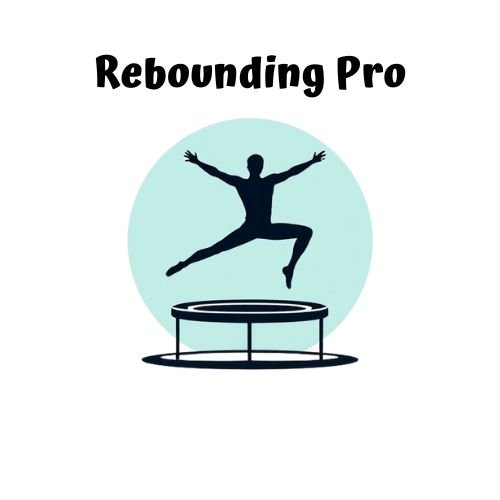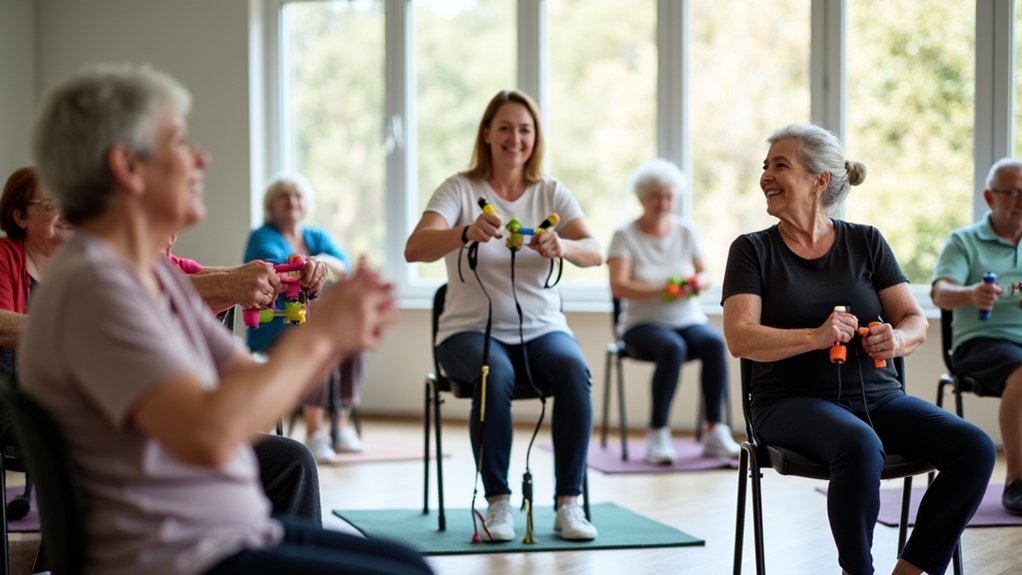Mini-trampoline workouts uniquely challenge your core through constant micro-adjustments on an unstable surface. You’ll activate deep abdominal muscles that traditional exercises miss while improving balance and coordination. Start with basic exercises like knee pulls and single-leg balances, then progress to advanced moves like trampoline planks and 360-degree turns. Perform barefoot or in grippy socks for safety, and always begin with a gentle 5-minute bounce warm-up. Discover how combining dynamic movements with stability training transforms your entire core.
Why Rebounding Creates Unique Core Challenges

When you step onto a mini-trampoline, you’re immediately engaging your core in ways traditional floor exercises simply can’t match. The unstable surface demands constant micro-adjustments from your deep abdominal muscles, particularly your transverse abdominis.
The unstable surface of a mini-trampoline activates your deep core muscles through constant micro-adjustments impossible to replicate on solid ground.
Unlike stable-surface workouts, rebounding challenges your core in multiple planes simultaneously. You’re not just working your abs in isolation—you’re training your entire core system to stabilize against unpredictable forces. This dynamic engagement actively prevents injuries while strengthening essential core muscles.
Your body must continuously react to the shifting surface beneath you, activating muscles throughout your trunk. This multi-dimensional loading creates an all-encompassing core workout as you twist, bounce, and shift laterally.
Your core muscles work overtime not just to generate movement, but to control it, absorbing impact and transferring energy between your upper and lower body.
Essential Mini-Trampoline Balance Exercises for Core Strength
Because your core serves as the foundation for all movement, targeted mini-trampoline exercises can dramatically enhance your stability and strength.
The unstable surface creates unique challenges that force deeper muscle engagement than traditional floor exercises.
Try incorporating these proven balance exercises into your routine:
- Knee Pulls – Lift one knee toward your midline while balancing, engaging your entire core stabilization system
- Single-Leg Balance – Stand on one leg for 30 seconds, activating core, back, and glute muscles
- Trampoline Plank – Position yourself in a plank on the rebounder for intensified core engagement
- 360-Degree Turns – Practice slow, controlled rotations to challenge your balance and coordination
- Alternating Foot Taps – Rapidly tap feet to develop dynamic stability and reaction time
Transition smoothly between exercises with 15-second transitions to maintain an efficient flow while keeping your core engaged throughout the entire workout.
Progressing Your Balance Work: From Beginner to Advanced

You’ll need a structured approach to mini-trampoline balance work that progressively challenges your stability systems.
Start with foundational exercises like static holds and marching in place before advancing to intermediate movements that incorporate weight transfers and directional stepping.
As your confidence grows, tackle single-leg challenges like deadlift bounces and scissors jumps to maximize your core engagement while maintaining proper alignment. The unstable surface of a mini trampoline naturally increases core activation and muscle stability throughout your balance training.
Balance Progression Essentials
Mastering balance requires a methodical approach that evolves as your stability improves. Your mini-trampoline journey should start with foundational stability drills like low-impact bouncing and static stance variations before advancing to dynamic movements.
Begin with supported exercises, gradually reducing dependence on hand bars as your confidence grows. The elastic surface challenges your proprioception, making even simple movements effective for balance training. Remember to keep your feet hip-width apart with equal weight distribution to establish a solid foundation for all balance work.
- Progress from static holds to dynamic weight shifts before attempting directional changes
- Incorporate visual focus training by tracking objects while maintaining stability
- Add arm movements to disrupt your center of gravity in controlled ways
- Use resistance bands to activate postural muscles during basic exercises
- Gradually introduce sensory challenges like brief eyes-closed intervals to enhance vestibular adaptation
Mastering Single-Leg Challenges
Single-leg training stands as the ultimate test of balance on a mini-trampoline, taking your stability work to remarkable new heights. By challenging your body to maintain equilibrium on one foot, you’ll engage your core muscles intensely while strengthening the muscles around your ankles.
Begin with basic single-leg stands without bouncing, then progress to gentle bounces once you’ve established confidence. As your skills develop, incorporate single-leg squats and heel raises to further challenge your stability. For maximum benefit, try incorporating moves like side kicks while stabilizing on one foot, similar to what’s done in quick six-minute rebounding routines. Always alternate legs to guarantee balanced development.
For safety, use handrails when starting out and verify your trampoline sits on a stable surface.
These exercises benefit everyone—from seniors looking to prevent falls to athletes enhancing performance and those rehabilitating from injuries. With consistent practice, you’ll transform your core strength and overall balance.
Combining Dynamic Movement With Stability Training
Every effective core training program balances dynamic movement with stability exercises to create thorough strength.
Your body’s deepest core muscles—transverse abdominis and multifidus—stabilize your spine while outer muscles like rectus abdominis and obliques drive movement. The mini-trampoline offers a perfect environment to challenge both systems simultaneously.
The mini-trampoline uniquely challenges both your core’s stabilizing and movement systems, creating comprehensive strength development through one dynamic tool.
When you combine dynamic bouncing with stability positions, you’ll:
- Engage your core’s deepest stabilizers while challenging movement patterns
- Enhance balance and reduce injury risk through multi-planar training
- Improve movement efficiency between your torso and limbs
- Progressive build functional strength that transfers to daily activities
- Create better integration between your upper and lower body during movement
This combination approach develops core muscles more thoroughly than either stability or movement training alone. A logical progression from stabilization phase to strength and power moves is essential for preventing injury and optimizing performance gains.
Equipment Considerations for Safe and Effective Core Rebounding

Four essential equipment factors determine the effectiveness and safety of your core rebounding workouts.
First, prioritize sturdy steel frames with anti-slip legs that support your weight limit and include safety pads over springs to prevent injuries during intense movements.
Choose trampolines with at least a 36-inch diameter and non-slip surfaces that provide ideal elastic resistance through 30+ tension bands. This combination guarantees proper rebound for abdominal engagement while reducing joint impact.
Consider models with LCD monitors to track your progress and those compatible with detachable handlebars for challenging oblique exercises. Many now offer mobile integration for specialized core routines.
Always inspect your equipment before workouts, exercise barefoot or in grippy socks, and maintain adequate clearance space to maximize safety during your rebounding sessions. For optimal balance training, select models with bungee cord systems rather than traditional springs for a quieter, gentler bounce that still challenges core stability.
Incorporating Balance Challenges Into a Complete Trampoline Workout
With your equipment properly set up, you’re ready to enhance your rebounding routine with targeted balance exercises. Start with basic marching in place to engage your core muscles before progressing to more dynamic movements. You’ll strengthen both large and small stabilizer muscles while improving coordination through deliberate balance challenges.
- Begin with a 5-minute bounce warm-up to prepare your muscles and joints.
- Incorporate lateral movements like side skis to develop stability and work different muscle groups.
- Try single-leg exercises such as knee-to-chest kicks to intensify core engagement.
- Hold balance positions progressively longer to enhance muscle control.
- Finish with heel raises to strengthen calves while improving overall stability.
Consider incorporating quarter turns with jack arms to challenge your balance while engaging your upper body simultaneously.
As you gain confidence, gradually increase difficulty by combining movements or reducing stability assistance.
Frequently Asked Questions
How Many Calories Can a Mini-Trampoline Core Workout Burn?
You’ll burn between 6.9-12.4 calories per minute on a mini-trampoline core workout. That’s 165-470 calories in 30 minutes, depending on your weight, intensity level, and exercise duration.
Can Seniors Safely Perform Balance Exercises on Mini-Trampolines?
Yes, you can safely perform balance exercises on mini-trampolines as a senior, especially with safety handles, proper supervision, and exercises tailored to your abilities. Always get medical clearance first for best results.
Will Trampoline Workouts Help With Lower Back Pain?
Yes, trampoline workouts can help your lower back pain. They’re low-impact, strengthen your core muscles, improve flexibility, and reduce spinal pressure. Start with gentle bouncing and gradually increase intensity as your back strengthens.
How Does Rebounding Compare to Traditional Core Exercises?
Rebounding offers more joint-friendly core training than traditional floor exercises. You’ll engage deeper core muscles through constant micro-adjustments, burn more calories, and build functional strength while enjoying reduced impact on your spine.
Can Children Benefit From Mini-Trampoline Balance Training?
Your child will develop stronger balance, coordination, and core muscles through mini-trampoline training. They’ll also enhance cognitive function, improve proprioception, and build foundational motor skills while having fun bouncing and stabilizing.
In Summary
Your mini-trampoline isn’t just for cardio—it’s a powerful core strengthening tool that challenges your balance in ways solid ground can’t. By progressively incorporating these stability exercises into your routine, you’ll develop functional core strength while having fun. Remember to choose quality equipment and combine static holds with dynamic movements. Your body will thank you with improved balance, posture, and overall stability.





Leave a Reply